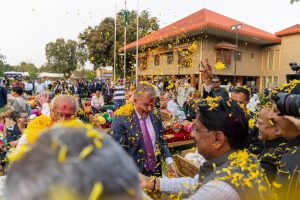During Australian Prime Minister Anthony Albanese’s trip to India last week, his Indian counterpart, Narendra Modi, raised concerns about the recent vandalism of Hindu temples in Melbourne. This vandalism has included graffiti with slogans promoting the idea of Khalistan, the proposed Sikh separatist state. No one has yet been identified and charged for these incidents. Given the passions involved, this issue has gained attention within the Indian media, leading to it being raised at the prime ministerial level.
While Modi was concerned about vandalism of Hindu temples, community tensions within the Indian diaspora in Australia have also included physical attacks on Sikhs, as well as a recent clash between Hindu and Sikh groups in central Melbourne. In response, the Australian government should be clear with the Indian government that every community within Australia has the right to live in peace and have their physical security, as well as their cultural and religious institutions, protected. There should be no favored groups.
Left unchecked, these tensions have the potential to poison the bilateral relationship, as well as threaten domestic support for Australia’s immigration program – an essential tool of Australia’s overall capabilities. Australia has become a highly successful multicultural country due to an implicit compact between the country and its migrant communities that culture is welcome, but conflict is not. A small, but active, number of Indian Australians are not keeping their end of the bargain.
Given its importance, governments in Australia may have to be more explicit about this compact. However, this also opens up an opportunity for some creative thinking about engagement with the Indian Australian community. The Victorian state government currently has a unique tool at its disposal that could be presented as a potential social pact, one that could alleviate at least the physical demonstrations of these tensions.
Despite being the center of Indian migration to Australia, Melbourne lacks a serious Little India precinct. There is a small strip in the southeastern suburb of Dandenong, and some recent concentrations of Indian businesses in West Footscray to the city’s west, but there is no central hub akin to Chinatown. As I have written previously, Melbourne is rapidly becoming one of the great South Asian cities outside of South Asia, but in order to fulfill this potential the city needs a prominent public space where these cultures can concentrate.
Usually these urban areas form organically, and finding central areas in well established cities can be difficult. However, directly south of Melbourne’s central business district is the recently rezoned industrial area of Fishermans Bend. It is the largest urban renewal project in Australia and the most extraordinary opportunity for Melbourne to enhance its standing as a major global urban center, if done right.
Thinking outside the box, there is a carrot and stick that the Victorian government could present to the Indian-Australian community. A parcel of land could be carved out of Fishermans Bend for a significant Little India precinct, with businesses, restaurants, as well as cultural and religious institutions. This area should, of course, also be highly accommodating to people from Pakistani, Bangladeshi, Nepali, and Sri Lankan backgrounds.
But the stick would be that planning for such a precinct can be halted and withdrawn should tensions within the local Indian Australian community persist. Such an initiative would give community leaders both the incentive and responsibility to control tensions within their communities. It would hopefully create the impetus to redirect people’s emotional investments away from communal tensions within India and toward helping to build a positive, vibrant, and prosperous future in Australia.
Of course, such a venture would rely on the Victorian government building the Metro 2 train-line underneath the Yarra River from the western suburbs and up through Fishermans Bend to the central business district – as accessibility to the precinct is currently lacking. Unfortunately, due to an ingrained belief within the government that infrastructure is only necessary once a problem becomes untenable, this metro line has been given a low priority – weakening attraction to the area and making the success of the Fishermans Bend urban renewal project in its entirety questionable.
Both the Victorian and federal governments should recognize that tensions within the Indian Australian community are quickly becoming untenable themselves, with their potential to spiral out into a number of facets of Australian domestic and international relations. Therefore serious thought and investment needs to be dedicated to the issue. This won’t be easy, as communal tensions are highly emotive and actively cultivated transnationally, with adherents existing within partisan media ecosystems that ferment chauvinistic sentiments. These emotions cannot simply be turned off like a tap. Therefore innovative and long-term solutions are required.
Until now, Australia’s success as a multicultural country has been due to its hands-off approach. The country has trusted people will understand the implicit compact to leave conflict behind, and the overwhelming majority of people – including most Indian Australians – embraced this, knowing that future rewards are greater than past or present grievances.
Given the modern global communication environment and the emotional in-group investments this animates, this hands-off approach may need to be reconsidered. However, Australia’s response doesn’t have to be stern and restrictive. Instead it is an opportunity to think creatively, to see the whole chessboard of statecraft, and try to redirect negative emotions into constructive and compelling outcomes for the country as a whole.

































